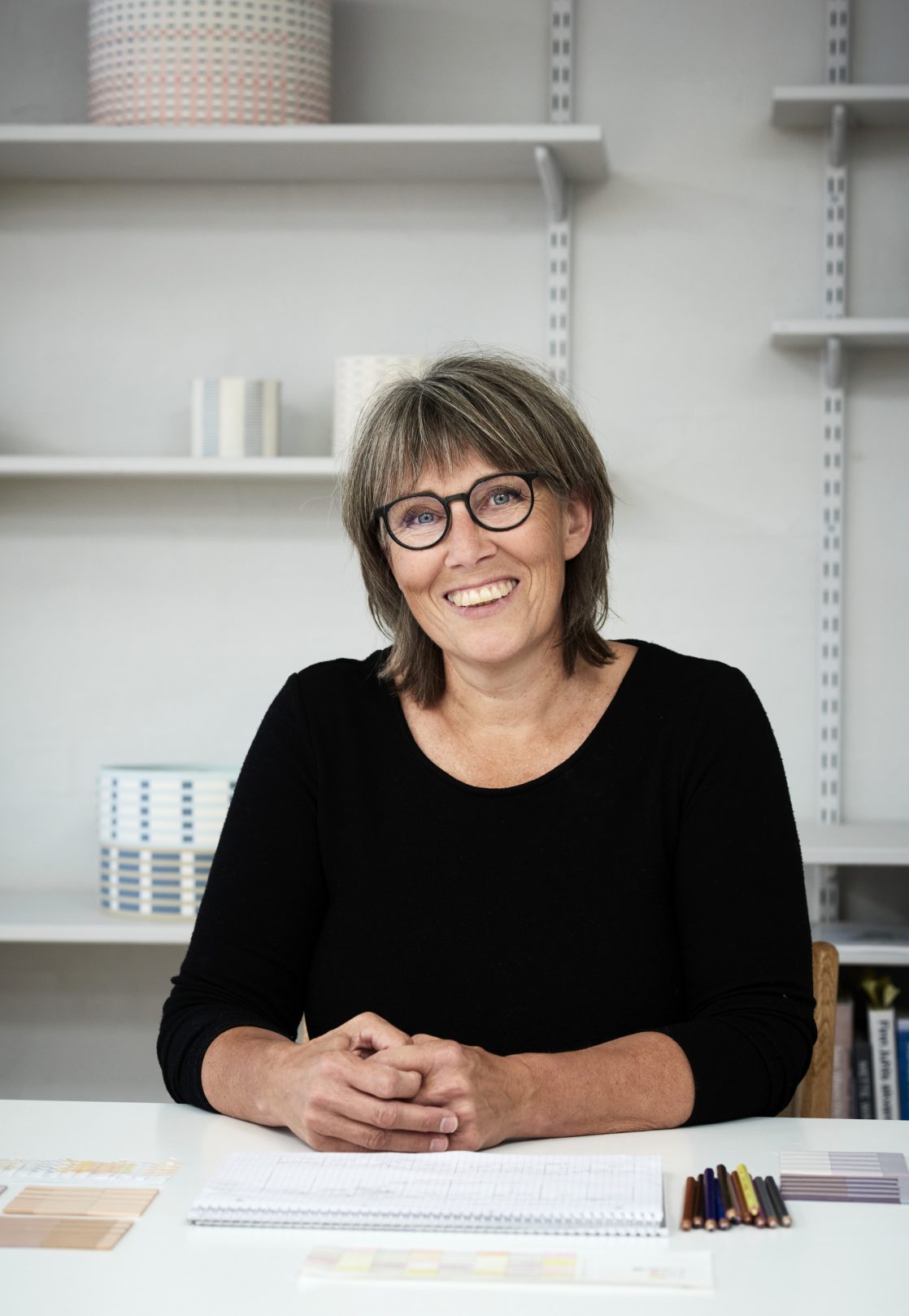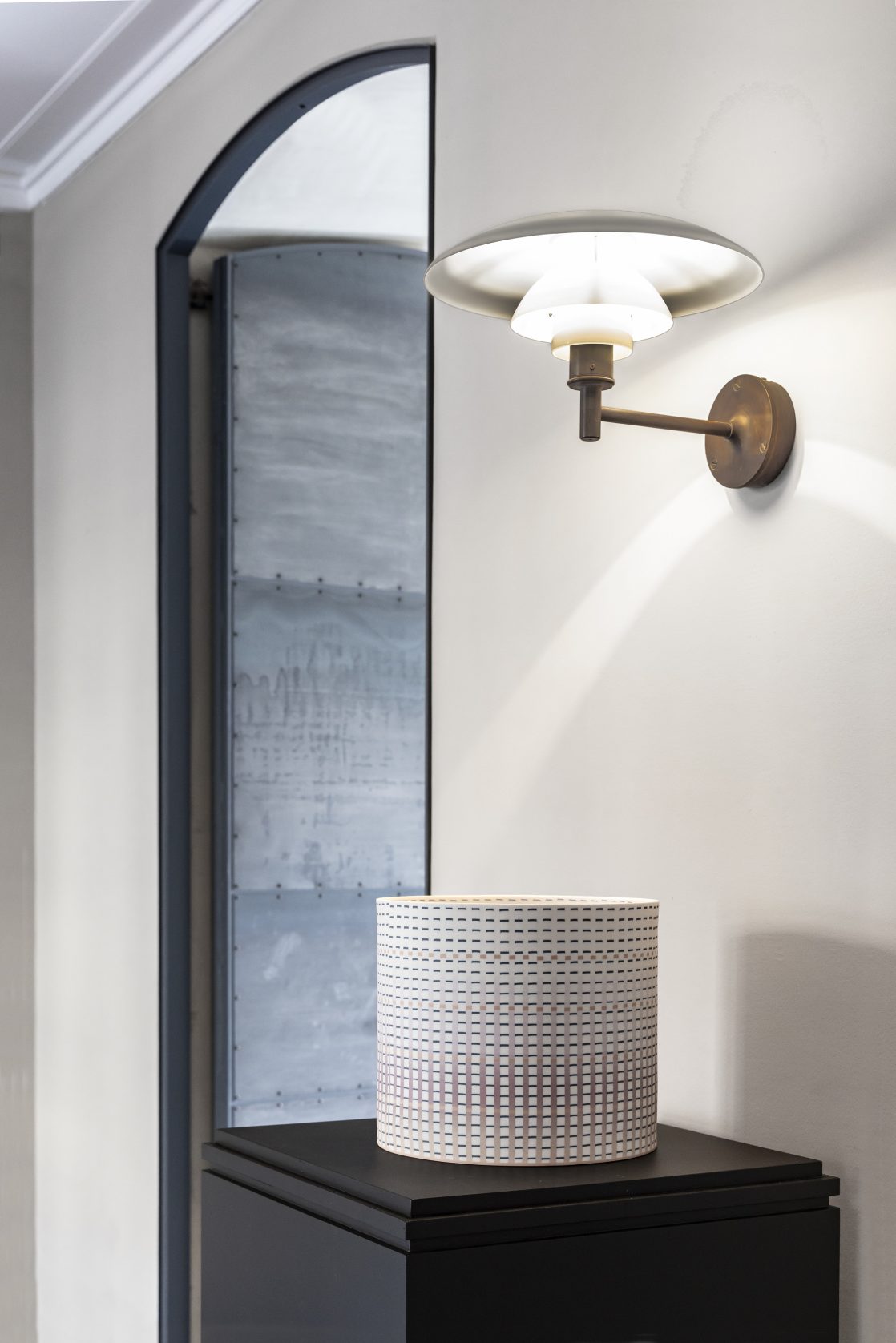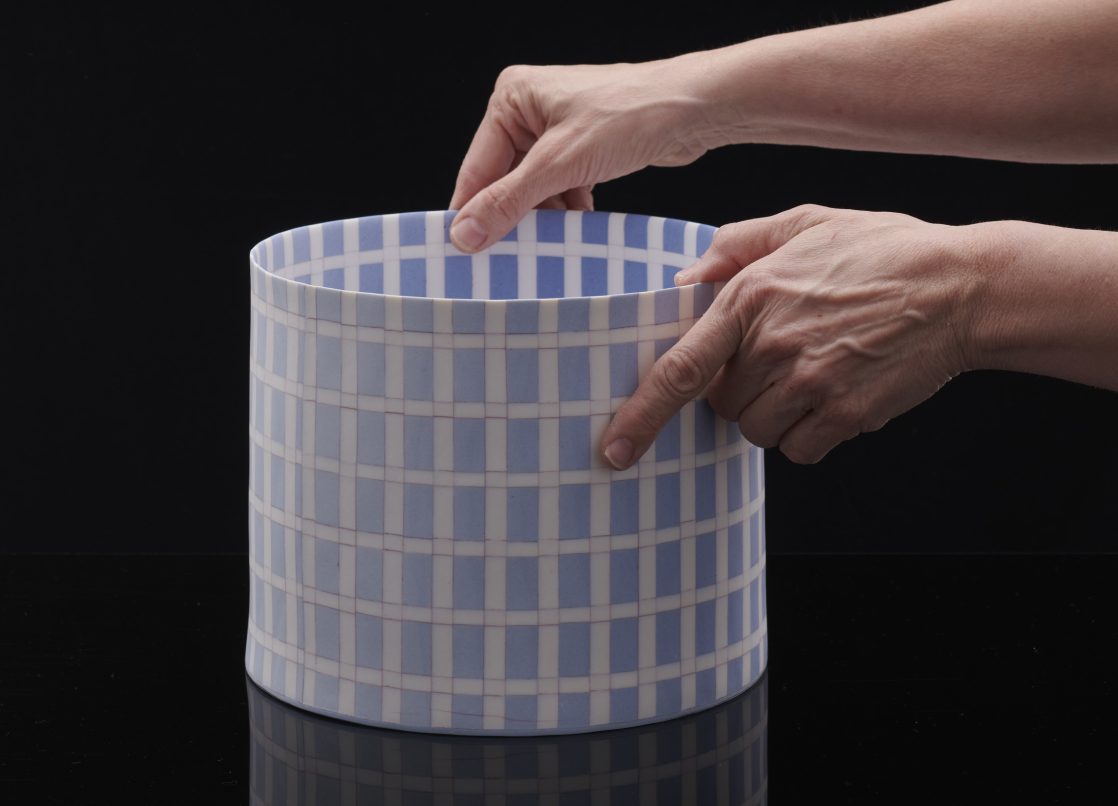Welcome to Ceramic Review
Ceramic Review is the magazine for contemporary and historical ceramics, ceramic art and pottery.
Ceramic Review Issue 334
July/August 2025
Ceramic Review is the magazine for contemporary and historical ceramics, ceramic art and pottery.
July/August 2025
Natalie Baerselman le Gros discovers the influences and techniques behind Lotte Westphael’s porcelain cylinders

Lotte Westphael’s studio in Silkeborg, Denmark, is bright, clean and highly organised. Every day begins, enviously, with a dip in the nearby lake, a walk through the trees and hot tea. It ends with a thorough cleaning of her workspace, ready for a new day of creativity. Her works are no less precise and considered: they are shrines to refinement of process, a deep consideration of line and colour, and beautiful in a way that transcends the Danish craft continuum into pure artistic triumph.
Westphael is best known for epically thin, tangibly fragile porcelain cylinders, built of rippling colour gradients and gridded slip joins that appear to work against gravity. All Danish ceramicists work in the shadow of a rich national history, but Westphael’s work combines far reaching interests and influences.
The artist’s earliest memory of clay is at five years old, growing up on a farm where her father discovered clay when digging to install a water tank. She shaped a small mother and child figurine that she still has today. ‘I remember the magic of taking material from the ground and shaping it into something,’ she recalls.
Despite being a keen mathematics and physics student at high school, Westphael also enjoyed classes in clay and ceramics and went on to study at Skals Folk School, common in Nordic countries, that focussed on creative learning. She studied drawing, weaving and sewing, but focussed on ceramics. She was introduced to different techniques, learning how to model and throw on a potter’s wheel.
JAPANESE INFLUENCE
Westphael references an influential exhibition she attended of Gertrud Vasegaard – a Danish ceramicist who is well known for her graphically decorated cylinders. But the most significant influence in her early education at folk school was her introduction to the crafts and aesthetics of Japan.
In 1986, at the age of 21, she was determined to visit Japan and organised a two week stay with a family there. By luck, a friend of her host was a ceramic enthusiast who introduced Westphael to a local potter and she spent six months under the tutelage of Kazu Nagayoshi. In the morning she cleaned the studio and wedged clay, and in the afternoon, she practised her techniques and visited museums and galleries.
Westphael would return to Japan again as an apprentice in the studios of Donna Gilliss and Mamoru Teramoto. She marks this as a formative event in the making of her career and the location of her aesthetic formation: ‘I found a long-term way of looking at craft, I internalised the appreciation of the tea bowl after attending a tea ceremony, its whole story is in the surface’.
Upon returning to Denmark, she attended the Kolding School of Art and Design and recalls a series of inspirational guest teachers, including Takeshi Yasuda, who taught the students to throw very large cylinders. Yasuda told the class: ‘you don’t fail enough, I want you to fail more, to go to the limit!’ Westphael described how this has stayed with her since then, striving to push her vessels bigger and walls thinner.
She can trace her current aesthetic style back to a specific point in her practice, when she entered a competition in Denmark with the theme of ‘to pack’, for which she made tall cylindrical vessels imprinted with the textures of packing materials (such as corrugated cardboard and ribbon bows), decorated with cut and inlaid graphic colour and glazed. She saw the artistic potential of the inlaid colour patterns and wanted to explore this more, seeing similar qualities in layered Japanese Kimono textiles. She stopped glazing her works and embraced the natural texture of clay, in order to allow focus on her patterned colours.


Continuing to find inspiration in rhythms made in woven textiles, Westphael became more interested in pattern as structure rather than surface. ‘I discovered it wasn’t very interesting to have one colour with another just on top, so it looked different from the outside and the inside, I wanted a conversation between the two,’ she explains. And so, she abandoned her inlay colour process and began to mosaic together small tiles of colour, using a different coloured slip in between to define each section and signpost her technique of pattern as structure.
From a distance, Westphael’s works look pin perfect and in her early works this is what she strived to achieve. She grew frustrated by the volatility of clay and the formal manifestations of imperfection she saw in the surface of her works. Indeed, the surfaces are not perfect but bear the will of the clay, each colour endures a different shrinkage rate, depending on the level of stain or oxide within it, resulting in small flexes and undulations.
In 2014, she took part in a porcelain masterclass in Hungary that encouraged her to embrace the imperfections ‘as a gift from the material’. Just like the tea bowls she had held in Japan, she hopes people will engage with her work on this level of detail, to understand that the work does not end when her hands leave its surface. Perhaps this is a sort of Danish wabi-sabi: finding beauty in the imperfections and embracing the natural eventualities of the work and the process… Perhaps not to the same extent as a Japanese tea bowl but maybe with a certain Danish-ness, ‘imperfection’ amongst a quintessentially refined and efficient aesthetic.
PATCHWORK PROCESS
Westphael’s work begins with small colour sketches, a hazy vision of the intended idea, before being mapped out more carefully when she gets to the problem-solving stage: how to technically achieve her vision. Strips of paper at a 1:1 scale are arranged together to explore colour combinations, gradations, and length and width of stripes. Occasionally she might stage her mocked up designs in a cylinder form because ‘the patterns are activated in the round, straight lines are not straight anymore, there’s something poetic to it’.
When transferring her chosen design to ceramic the process begins with careful wedging of colours and rolling slabs. Each is done by hand and one colour gradient can take up to a week to blend. Despite an often-mistaken visual similarity to weaving, Westphael’s practice is much closer to patchwork, cutting out each coloured square or rectangle and fixing them together in a large slab with coloured slips, mere millimetres thick. Her piece Golden Polyrhythm Gradient, acquired by the Design Museum in Copenhagen in 2021, is made up of over 5000 pieces and has over 50 different colour tones.
When complete she cleans the patchwork with a sponge to reveal its pattern, before transferring it to a cylindrical form and joining it to a base. Then it is left to dry for at least a month, before being fired very slowly, over three days, to 940°c. Westphael is mindful to control the decrease in temperature as much as the increase, to avoid stress cracks in the thin porcelain, and waits until it reaches 50°c before opening the kiln. To further refine the cylinder and bring out the clarity of the pattern, she polishes the surface with sandpaper for several days, before a final firing up to 1250°c. Her practice is very concentrated and marked by patience with each piece taking 2-3 months to make. She takes no chances, touching her cylinders as little as possible.


Westphael still finds her technique challenging, but she enjoys that. ‘I strive for complexity, it gives me energy and an attentiveness,’ she reveals. Her greatest creative challenge is coming back to the studio after completing an exhibition. ‘It’s very hard to get started again, it is much easier to be in the process when starting a new piece, to have an unfinished piece waiting for you.’
Upon discussing influences, she comments: ‘I remember hearing a classical singer talk about creativity, she wasn’t inspired by other singers because that channel was occupied and I feel the same way, finding inspiration in media other than ceramics.’ She refers often to the paintings of Agnes Martin, whose grids take a complex world and make it simple and Westphael agrees: ‘making patterns provides me with calm, it is like breathing out.’ Also, the textiles of Anni Albers, who described the structural dimensions of weaving in her work and said, ‘simplicity is not simpleness but clarified form’.
FINDING SIMPLICITY
Westphael hopes to maintain a visual simplicity in her work despite their multi-layered process and expression. She is also inspired by music, often referring to her cylinders as ‘syncopes’, a repetitious rhythm that emphasises the offbeat. In her work, she enjoys a sense of understated distortion or disturbance of the regular flow and strives for this in her generation of pattern. New ideas can begin with a walk in the woods, or a swim in the lake, by the chance arrangement of her colour tiles or from ideas left unresolved in a previous work. She is always thinking about ceramics.
Early works were driven by technical ambition, her mathematical brain seeing a challenge and figuring out how to solve it, but now she works to achieve an expression, an idea. She describes ambitions for future work as ‘seeking the light, vanishing into white, ephemeral and serendipitous’. In recent works, the wilful clay has been pushing the boundaries of her cylinders into undulating waves, demonstrating how simplicity can always be surprising and the clay always has the last word. Westphael lets it sing.
For more details visit @lottewestphael. She has recently been selected for the European Prize of Applied Arts in Belgium. Her work can be seen at PAD London, 8-13 October; padesignart.com
